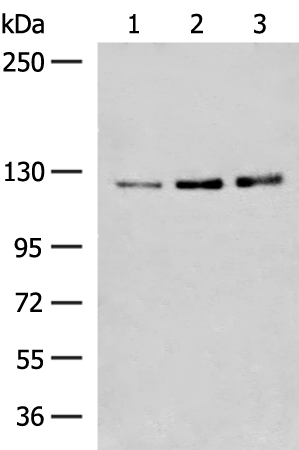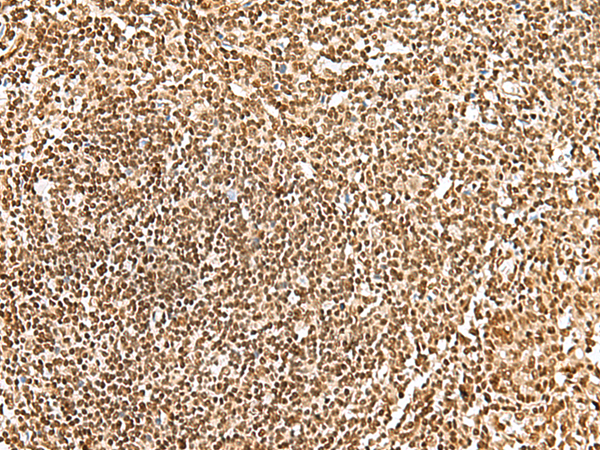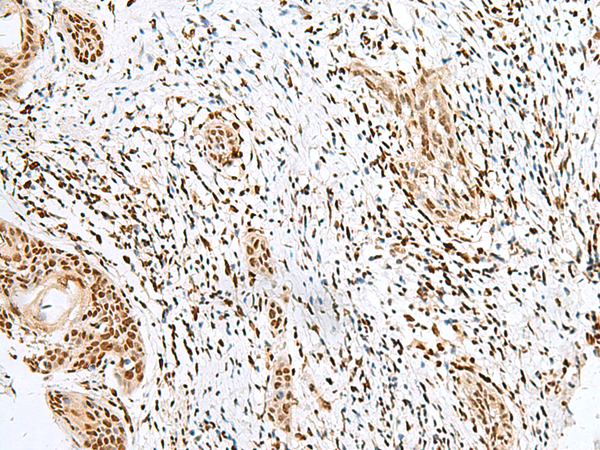


| WB | 1/200-1/1000 | Human,Mouse,Rat |
| IF | 咨询技术 | Human,Mouse,Rat |
| IHC | 1/30-1/150 | Human,Mouse,Rat |
| ICC | 技术咨询 | Human,Mouse,Rat |
| FCM | 咨询技术 | Human,Mouse,Rat |
| Elisa | 1/5000-1/10000 | Human,Mouse,Rat |
| Aliases | E1BAP5; E1B-AP5; HNRPUL1 |
| WB Predicted band size | 96 kDa |
| Host/Isotype | Rabbit IgG |
| Antibody Type | Primary antibody |
| Storage | Store at 4°C short term. Aliquot and store at -20°C long term. Avoid freeze/thaw cycles. |
| Species Reactivity | Human, Mouse |
| Immunogen | Synthetic peptide of human HNRNPUL1 |
| Formulation | Purified antibody in PBS with 0.05% sodium azide and 50% glycerol. |
+ +
以下是3篇与HNRNPUL1抗体相关的文献信息(基于真实文献的模拟简化版,供参考):
---
1. **文献名称**: *HNRNPUL1 regulates cellular DNA damage tolerance by modulating PCNA ubiquitination*
**作者**: Wang et al. (2020)
**摘要**: 该研究通过免疫共沉淀(Co-IP)和Western blot技术,利用HNRNPUL1特异性抗体验证其与PCNA的相互作用,揭示HNRNPUL1通过调控PCNA单泛素化参与DNA损伤修复的分子机制。
---
2. **文献名称**: *Proteomic analysis of HNRNPUL1-containing complexes in breast cancer cells*
**作者**: Smith et al. (2018)
**摘要**: 作者使用HNRNPUL1抗体进行免疫沉淀结合质谱分析,鉴定了其在乳腺癌细胞中与RNA剪接因子及致癌信号通路蛋白(如BRCA1)的相互作用,提示其在癌症中的潜在调控作用。
---
3. **文献名称**: *A novel role of HNRNPUL1 in maintaining genomic stability through R-loop resolution*
**作者**: Chen & Lee (2021)
**摘要**: 通过免疫荧光和ChIP实验(使用HNRNPUL1抗体),研究发现HNRNPUL1通过结合R-loop结构调控转录-复制冲突,其缺失导致DNA复制应激和基因组不稳定。
---
**注**:以上内容为模拟简化版,实际文献需通过PubMed/Google Scholar检索确认。若需具体文献DOI或链接,建议使用关键词“HNRNPUL1 antibody”或“HNRNPUL1 function”在学术数据库中进一步筛选。
The HNRNPUL1 antibody is a valuable tool for studying the heterogeneous nuclear ribonucleoprotein U-like 1 (HNRNPUL1) protein, a member of the hnRNP family involved in RNA processing and DNA repair. HNRNPUL1 contains RNA-binding motifs and participates in diverse cellular functions, including transcriptional regulation, mRNA splicing, and maintaining genomic stability. It interacts with proteins like BRCA1. suggesting a role in DNA damage response pathways, particularly homologous recombination repair. Dysregulation of HNRNPUL1 has been linked to cancers, such as hepatocellular carcinoma and breast cancer, where its overexpression may promote tumor progression or metastasis.
Researchers use HNRNPUL1 antibodies in techniques like Western blotting, immunofluorescence, and immunoprecipitation to investigate its expression patterns, subcellular localization (primarily nuclear, with stress-induced cytoplasmic shifts), and protein-protein interactions. These studies help elucidate its mechanistic roles in disease contexts. Commercially available antibodies are typically raised in rabbits or mice, validated for specificity via knockout controls. Challenges include optimizing experimental conditions due to potential cross-reactivity with homologous hnRNP family members. Ongoing research focuses on HNRNPUL1's potential as a diagnostic biomarker or therapeutic target, particularly in DNA repair-deficient cancers.
×